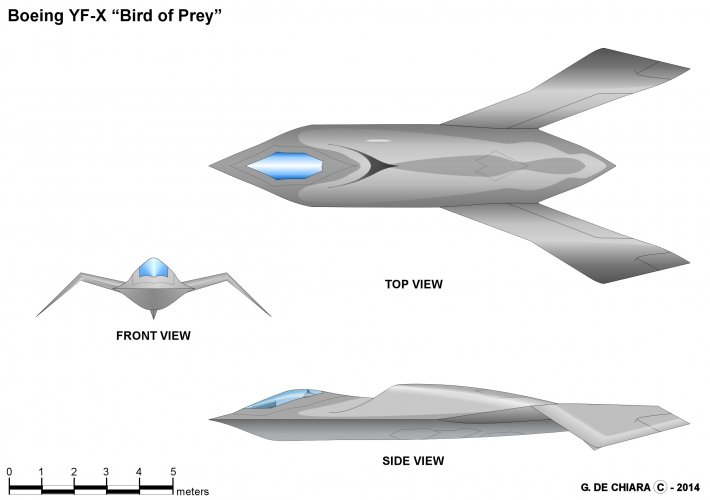You are using an out of date browser. It may not display this or other websites correctly.
You should upgrade or use an alternative browser.
You should upgrade or use an alternative browser.
Boeing Bird of Prey Demonstrator
- Thread starter flateric
- Start date
- Joined
- 2 August 2006
- Messages
- 3,254
- Reaction score
- 1,524
All aircraft are first flown in daylight JIC there's an emergency. I'm not sure why this is so surprising. They know if anyone is watching out at the test ranges, so they just schedule accordingly.I love how many images there are of every classified aircraft we know of, before declassification, taken midday and from a lower altitude.
- Joined
- 19 December 2011
- Messages
- 224
- Reaction score
- 437
Amen, brother. Making the maiden flight in daylight is generally necessary from a safety standpoint as well as for engineering documentation. The F-117A, which was specifically designed to operate in darkness, didn't start doing nighttime test sorties until its basic flight characteristics and handling qualities had been verified. That said, the "RQ-180" made "the only nighttime first flight in the history of aviation" as an extra security measure to prevent unauthorized persons from seeing the aircraft.All aircraft are first flown in daylight JIC there's an emergency. I'm not sure why this is so surprising.
Scott Kenny
ACCESS: USAP
- Joined
- 15 May 2023
- Messages
- 11,427
- Reaction score
- 13,938
Ho Lee Fook! That's a ghost and a half!There has been nothing definitive published, of course.
But it can be reasonably inferred that the signature is significantly lower. According to people familiar with the program, the visual signature became dominant - it could be seen with the eyeball before it could be seen using radar. The visual signature was then reduced by several means, and this was one of the primary goals of the project.
- Joined
- 1 April 2006
- Messages
- 11,366
- Reaction score
- 10,158
Attachments
Kerburettor
ACCESS: Restricted
- Joined
- 8 February 2021
- Messages
- 5
- Reaction score
- 9
Just correcting some mis-infos
The fact that the canards and main wings aren’t parallel, doesn’t prove that it’s dihedral.
Even if two lines are in the same plane, if they aren’t parallel, from any viewpoint it will still be remained unparallel

To be more specific, since the radar will not be facing the aircraft from the nose-on (that is to say along the longitudinal axis of the aircraft in the body frame of reference), but from slightly below that direction, the edges need to be aligned as seen from that direction to minimize front-facing specular reflections. In this regard, if the canards have a bit of dihedral, they may be slightly misaligned from the rest of the leading edges (wings, chine, HTP, etc.) as seen from the planform in order to appear aligned from the radar's perspective but not from the top view perspective. The presence of canards w/ dihedral makes the aircraft's stealth characteristics sensitive to the approach angle of the aircraft (which is a function of altitude and distance to the radar) and is not ideal.
- Joined
- 30 May 2023
- Messages
- 111
- Reaction score
- 207
Was there any synthesis of the learnings from YF-118G and X-36? Both were tailless and LO, but explored different particulars of flight and signature reduction.
Forest Green
ACCESS: Above Top Secret
- Joined
- 11 June 2019
- Messages
- 9,421
- Reaction score
- 17,162
archipeppe
ACCESS: Top Secret
- Joined
- 18 October 2007
- Messages
- 2,431
- Reaction score
- 3,146
Similar threads
-
-
All Weather Flying Center and Project Thunderstorm Aircraft.
- Started by Orionfield
- Replies: 17
-
-
-


